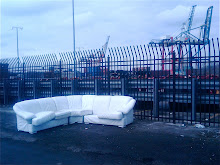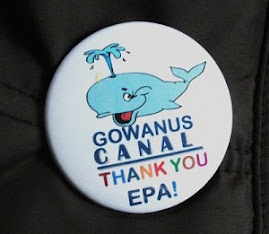
It's been a common complaint that when "the powers that be" bring their development plans to Red Hook, little ever materializes in the form of often promised benefits for the community - whether it be the for residents or small businesses.
Sure, IKEA brought some jobs to the locals, a nice waterfront park and a free customer water taxi service, but the promise of these thousands of new customers seeking other shopping options in the neighborhood hardly materialized. The quick demise of the newly renovated bar "Annabelle's" (formerly - and much missed - "Lillie's") and the adjoining restaurant "La Bouillabaisse" that were situated right across the street from IKEA is evidence of that. I guess people preferred their pseudo Swedish meatballs to the excellent Neil Ganick created cuisine to be had at the non-IKEA restaurant. Let's face it, who's going to load up their car with disassembled furniture and head out for some fine dining - day or night - especially when they've got many long and frustrating hours of reassembling ahead of them? I don't even think that the Liberty Heights Tap Room (now Rocky Sullivan's) benefited from the anticipated throngs of thirsty construction workers who were building the blue and yellow behemoth a mere block away.
Similarly, shouldn't we ask questions when the New York City Economic Development Corporation (EDC) says that they anticipate the relocation of 500 workers to Red Hook - with their newly inked plan to bring Phoenix Beverages to the Brooklyn Waterfront at Piers 7 and 11 at the Atlantic Basin - will bring great benefits to our community? The trade off to the locals for the imposition of 200 new truck trips a day, more congestion and pollution from the trucks and from the carcinogenic extra-dirty diesel smokestack pollution of the additional idling container ships is, they say, the great economic benefit it will bring. Not only to the City as a whole, but to Red Hook itself. Hey, they're the ECONOMIC Development Corporation ... they know what they're talking about, right?
Most of Phoenix's jobs, we've been told, will be truck drivers and the EDC said they were sure they'd (at least) be stopping in at the local eateries to grab some lunch or something. I wait with anticipation to see the "Hope and Anchor" packed with Phoenix drivers catching a bite in the middle of their day - returning to Red Hook after interrupting their run out to Long Island and beyond, their trucks double parked on Van Brunt Street, soon to drive back out to the suburbs with an excellent espresso from "Fort Defiance" in one hand and one of "Baked"'s fine cupcakes in the other. They'll no doubt be returning later that night to have a fine meal at "The Good Fork", "Home/Made" or "Kevin's" (to name a few) - you know, supporting their fellow Red Hook businesses.
There will be some good things coming with the EDC's plan - the accomodation of the Brooklyn Greenway and inclusion of PortSide New York in the plan is at least a small concession to the strong sentiment in our community, detailed specifically in many formats - whether it be Community Board 6 Guidelines, or our 197a Plan - for some sort of cultural element and meaningful waterfront access and public space. Unfortunately - and I don't want to sound like I'm minimizing the value of their presence and the contribution they will bring to this plan - but we're getting a lot less than what we asked for, and the public waterfront access has basically been reduced to a corner of a paved parking lot.
Still, the EDC said the plan will bring economic benefit to our community. Many of our small businesses showed great reluctance to agree with the EDC's assertions on this matter. Some asked what studies the EDC had done to show this was the fact - the answer was none. When the small store-owners and business people asked, in some of the community meetings, what the comparative economic benefit to the upland community of an alternate plan would be (one that included Phoenix in addition to the inclusion of New York Water Taxi's operations and more jobs, the development of other commercial activities, boat repair, a marina, cultural spaces and much more public access, waterfront access and open space), the EDC basically shrugged their shoulders. Apparently they don't collaborate with their non-Maritime Unit colleagues.
So it's with this in mind that I get back to the whole point - sort of - of this post. When the EDC were building the Brooklyn Cruise Terminal, at the bottom of my street, many of us had hopes that the benefits that they promised would come to our community from that development would come to fruition. Perhaps a few disembarking passengers would wander around the neighborhood and buy a few things at our cool shops - eat at a cafe or restaurant - buy a drink at a bar. Maybe some would drive around the neighborhood and see what an interesting place it was, and be lured back later? Surely the EDC would make the terminal itself a people friendly place that invited non-travelers to the waterfront to watch the ships, sit on a bench, or just lay on a grassy seaside public space, taking in the waterborne activity around them? Logically, the terminal building could be used as a convention or function center when the ships weren't in, no? The EDC is going to create a nice welcoming gateway to the terminal, and back into Red Hook - perhaps a gate at the pedestrian access at the bottom of Pioneer Street that said "Welcome to Red Hook, Brooklyn", with a guide to the local businesses, right? The EDC will surely ensure that the cruise ships don't have to idle while in port (by the implementation of "Cold Ironing" - the use of Shore Power so the ships can turn off), instead of churning their many tons of dangerous chemicals into our childrens' lungs, while their passengers pass through this brand spanking new, multi-million dollar, state-of-the art terminal to luxuriate on the Queen Mary 2 and sip on their flutes of Krug?
It didn't seem so far fetched.
Well, 6 years later, none of this has come to pass.
At least I thought not, until I had a conversation with my local bodega guy - Cliff. As I was buying my milk, I asked him -
"So, I see the ship's in today" (one of many sailings this last summer) ... "Are you getting any customers?".
"Nah", he said. "Just a few of the crew stopping in for soap, some toothpaste or whatever".
"Oh", I said.
"But the Chinese is doing well", Cliff offered. "They're rockin'".
So I took a look at our excellent and friendly local Chinese take-out, the "Ling Gee", and, yep, for sure they were busy. And after that, whenever I noticed that the ships were in - especially the Princess lines, for some reason - the little restaurant seemed to be doing a thriving business. With crew members from the ship filing in, sometimes having to wait outside, and then taking some time to sit at the window and slurp up some freshly prepared noodles or house special soup (they have a good one).
Hey, I thought. The EDC was right.
At last, some benefit for the local businesses .....
Well, for one at least.








